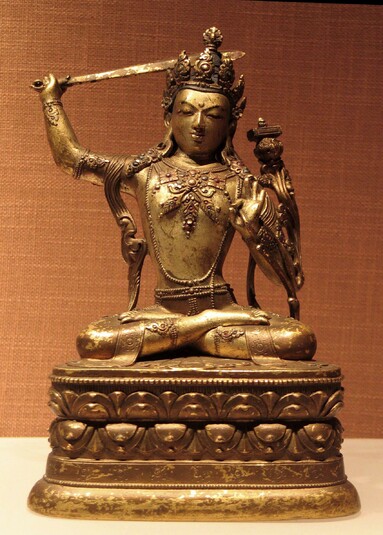
Item: Manjushri (Bodhisattva & Buddhist Deity) - Arapachana
| Origin Location | Mongolia |
|---|---|
| Date Range | 1700 - 1799 |
| Lineages | Buddhist |
| Material | Metal |
| Collection | The Capital Museum, Beijing, China |
Classification: Deity
Appearance: Peaceful
Gender: Male
Arapachana Manjushri, white or orange (Tibetan: a ra pa cha na jam pal yang. English: Arapachana the Splendid Melodious Voiced One). A meditational deity, with the appearance of a bodhisattva, representing the wisdom of all the Buddhas of the ten directions and three times.
Sanskrit: Manjushri Tibetan: Jam pal yang
Tibetan: Jam pal yang
"...Arya Manjushri with a body orange in colour, having the colour of fresh saffron, one face and two hands. The right holds aloft the sword of wisdom severing ignorance and in the left the stem of an utpala to the heart, blossoming at the ear with the Prajnaparamita book above. With the feet seated in vajra posture, having jewel ornaments and upper and lower garments of silk, the hair tied to the left in five tufts - [some] loose; having the appearance of a youth of sixteen years. A moon disc with the nature of light supports the back." (Sakya Lotsawa Kunga Sonam (1485-1533), 23rd Throne Holder of Sakya. sGrub Thabs Kun bTus, vol.2, fol.258-261. Translated into English by (c)Jetsun Kusho Chimey Luding and Jeff Watt. May 1984).
Arapachana Manjushri is a meditational deity in Vajrayana Buddhism. He is generally classified as either Kriya or Charya Tantra. In terms of function Manjushri is typically categorized as a wisdom deity - meaning a meditational deity that promotes the increase of wisdom, knowledge, memory, language skills, etc. There are several different forms of Arapachana Manjushri and there are several forms of Manjushri that look like Arapachana but are not.
Arapachana as described in early texts is white in colour, but according to 12th and 13th century Kadampa and Sakyapa teachers can also be orange. Generally in Tibetan art the colour orange is not consistent between centuries and artists. The colour of the deity is often described as orange like the rising sun. The variations can range from yellow, to tangerine, to bright orange.
The White Arapachana can be either solitary in appearance or have four retinue attendant figures. The orange form of Arapachana is solitary. Older art works for both painting and sculpture depict the left hand holding a book to the heart. Later art works depict the right hand holding the stem of a blue utpala flower at the heart with the blossom at the left ear supporting a book. An early text describing the practice and rituals of Arapachana is the Siddhaikavira Tantra.
Five Hundred Pandita Prayer:
"He whose intellect is free of the clouds of the two obscurations, completely clear like the sun, seeing, however many all meanings as they are, holds a book to his heart.
Discoursing with sixty separate melodious tones and a love for all the hosts of beings tormented by suffering, covered with the darkness of ignorance in the prison of existence, like for an only child.
Roaring loudly like a dragon to wake from the two afflictions, to free from the shackles of karma, and to clear the darkness of ignorance; severing the seedlings of misery, however many, holding a sword.
Pure from the beginning and reaching the tenth stages end, a complete body of qualities; principal form of the Buddha's sons.
Adorned with one hundred and twelve ornaments, clearing the darkness of my intellect; homage to Manjushri-ghosha." [Five Hundred Panditas Prayer. Translated by Jeff Watt, Vancouver, Canada. May 1984].
Jeff Watt 7-2012
Buddhist Deity: Manjushri Main Page
Sculpture: Zanabazar Style (Peaceful Appearance)
Buddhist Deity: Manjushri, Arapachana (Meditation Examples)
Collection of The Capital Museum, Beijing
Buddhist Deity: Manjushri, Arapachana (Main Page)
Buddhist Deity: Manjushri Sculpture Page
Sculpture: Zanabazar Style (Mongolia)
Buddhist Deity: Manjushri (Sculpture Masterworks)
Buddhist Deity: Manjushri, Arapachana (Mongolian Sculpture Masterworks)
Buddhist Deity: Manjushri (Mongolia)
Buddhist Deity: Manjushri, Arapachana (Sculpture Masterworks)

